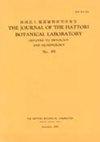Bioproduction of lichen phenolics by immobilized lichen cells with emphasis on the role of epiphytic bacteria
引用次数: 12
Abstract
SUMMARY. Since 1966, immobilization of lichen cells or enzymes in inert, hydrophilic matrices by adsorption or entrapment is the usual method to improve the production of lichen metabolites without biomass destruction. Alginate and polyacrylamide are used for cell entrapment, whereas bioskin, clays or polyhydroxyurethane have been largely preferred as matrices for immobilization by adsorp tion. Entrapped or adsorbed cells can be used to induce a particular metabolic transformation, i.e., lecanoric acid into orsellinic acid, or, alternatively, to produce lichen phenolics from acetate as a pri mary precursor. The overall production of some of these phenolics, such as evernic and usnic acids, atranorin, parietin and fumarprotocetraric acid, is reviewed and analyzed the possible role in the process of phenolic production and accumulation of epiphytic bacteria contaminating lichen immo bilisates.固定化地衣细胞生产地衣酚类物质,重点讨论附生细菌的作用
总结。自1966年以来,通过吸附或包埋将地衣细胞或酶固定在惰性亲水性基质中是在不破坏生物量的情况下提高地衣代谢物产量的常用方法。海藻酸盐和聚丙烯酰胺被用于细胞包裹,而生物皮、粘土或聚羟基聚氨酯被广泛用作吸附固定的基质。包裹或吸附的细胞可用于诱导一种特定的代谢转化,即,将lecanoric酸转化为orsellinic酸,或者,作为主要前体的乙酸产生地衣酚类物质。本文综述了一些酚类物质的总体生产情况,如绿曲霉酸和茴香酸、曲霉酸、parietin和富马原三酸,并分析了污染地衣免疫胆酸酯的附生细菌在酚类物质生产和积累过程中的可能作用。
本文章由计算机程序翻译,如有差异,请以英文原文为准。
求助全文
约1分钟内获得全文
求助全文

 求助内容:
求助内容: 应助结果提醒方式:
应助结果提醒方式:


